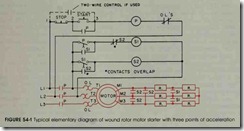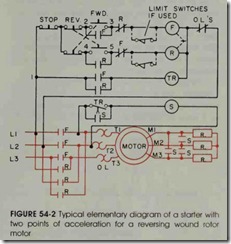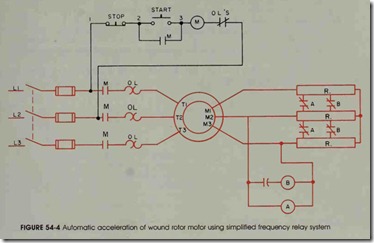Objectives
After studying this unit, the student will be able to:
• State the advantages of using controllers to provide automatic acceleration of wound rotor motors
• Identify terminal markings for automatic acceleration controllers used with wound rotor motors
” Describe the process of automatic acceleration using reversing control
• Describe the process ·of automatic acceleration using frequency relays
• Connect wound rotor motor and automatic acceleration and reversal controllers using push buttons and limit switches
• Recommend troubleshooting solutions for these problems
Secondary resistor starters used for the auto matic acceleration of wound rotor motors consist of (1) an across-the-line starter for connecting the primary circuit to the line and (2) one or more accelerating contactors to shunt out resistance in the secondary circuit as the rotor speed increases. The secondary resistance consists of banks of three uniform wye sections. Each section is to be connected to the slip rings of the motor. The wir ing of the accelerating starters and the design of the resistor sections are meant for starting duty only. This type of controller cannot be used for speed regulation. The current inrush on starters with two steps of acceleration is limited by the sec ondary resistors to a value of approximately 250 percent at the point of the initial acceleration. Re sistors on starters with three or more steps of acceleration limit the current inrush to 150 percent at the point of initial acceleration. Resistors for ac celeration generally are designed to withstand one 10-second accelerating period in each 80 seconds of elapsed time, for a duration of one hour without damage.
The operation of accelerating contactors is controlled by a timing device. This device pro vides timed acceleration in a manner similar to the operation of primary resistor starters. Normally, the timing of the steps of acceleration is controlled by adjustable accelerating relays. When these tim ing relays are properly adjusted, all starting peri ods are the same regardless of variations in the starting load. This automatic timing feature elim inates the danger of an improper startup sequence by an inexperienced machine operator.
The primary circuit (stator) in figure 54-1 is energized with the start button. The motor starts with a full value of resistance in the secondary cir cuit. Coil P actuates the normally open, delay-in closing contact P. After a preset timing period, contact P closes, energizes contactor S1, and maintains itself through the maintaining contact Sl. When contacts S1 in the secondary resistor circuit close, the motor continues to accelerate. After the normally open, delay-in-closing contact S1 times out and closes, contactor S2 is energized and closes the resistor circuit contacts S2. The motor then is accelerated to its maximum speed. The normally closed interlock S2 opens the con tactor (S1) circuit. The closing of S2 is assured by staggered, or overlapping, control contacts S2.
AUTOMATIC ACCELERATION WITH REVERSING CONTROL
Automatic acceleration can be obtained in ei ther direction of rotation with the addition to the circuit of reversing contactors and push buttons. The wiring of these devices is shown in figure 54-2.
As described for a squirrel cage motor, a wound rotor motor can be reversed by interchang ing any two stator leads.
The motor may be started in either direction of rotation-at low speed with the full secondary resistance inserted in the circuit. For either direc tion of rotation, the timing relay TR is energized by the normally open auxiliary contacts (F or R). Coil TR activates the normally open, delay-in closing contact TR. Coil S is energized when con tact TR times out and closes, and removes all of the resistors from the circuit to achieve maximum motor speed. The primary contactors are inter locked with the push buttons, normally closed in terlocking contacts R and F, and the mechanical devices. The connections that occur if a limit switch is used are shown by the dashed lines in figure 54-2. The motor will stop when the limit switch is struck and opened. In this situation, it is necessary to restart the motor in the opposite di rection with the push button. As a result, lines 1 and 3 on the primary side will be interchanged. Of course if limit switches are used, the jumper wire must be removed to avoid shunting out the oper ation of the limit switches.
AUTOMATIC ACCELERATION USING FREQUENCY RELAYS
Definite timers or compensated timers may be used to control the acceleration of wound rotor motors. Definite timers, which usually.consist of pneumatic or dashpot relays, are set for the high est load current and remain at the same setting regardless of the load. The operation of a compen sated timer is based on the applied load. In other words, the motor will be allowed to accelerate faster for a light load and slower for a heavy load. The frequency relay is one type of compensating timer. This relay uses the principle of electrical resonance in its operation.
When a 60-hertz ac, wound rotor motor is ac celerated, the frequency induced in the secondary circuit decreases from 60 hertz at zero speed to 2 or 3 hertz at full speed, see figure 54-3. The volt age between the phases of the secondary circuit decreases in the same proportion from zero speed to full-speed operation. At zero speed, the voltage induced in the rotor is determined by the ratio of the stator and rotor turns. This action is similar to the operation of a transformer. The frequency, however, is the same as that of the line supply. As the rotor accelerates, the magnetic fields induced in it almost match the rotating magnetic field of the stator. As a result, the number of lines of force cut by the rotor is decreased, causing a decrease in the frequency and voltage of the rotor. The ro tor never becomes fully synchronized with the ro tating field. This is due to the slip necessary to achieve the relative motion required for induction and the operation of the rotor. The percentage of slip determines the value of the secondary fre quency and voltage. If the slip is five percent, then the secondary frequency and voltage are five per cent of normal.
Figure 54-4 illustrates a simplified frequency relay system operated by push-button starting. This system has two contactor coils connected in parallel (A and B) and a capacitor connected in series with coil B. A three-step automatic acceler ation results from this arrangement. When the motor starts, full voltage is produced across coils A and B, causing normally closed contacts A and B to open. The full resistance is connected across the secondary of the motor. As the motor acceler ates, the secondary frequency decreases. This means that coil B drops out and contacts B close to decrease the resistance in the rotor circuit, re sulting in continued acceleration of the motor. The capacitor depends upon the frequency of an alternating current. As the motor continues to ac celerate, coil A drops out and closes contacts A, accelerating the motor further. Because the nor mally closed contacts are used, the secondary of the motor cannot be shunted out completely. If the secondary could be completely removed from the circuit, the electron flow would take the path of least resistance, resulting in no energy being de livered to coils A and B upon starting.
The controllers for large crane hoists have a resistance, capacitance, and inductance control circuit network that is independent of the second ary rotor resistors.
Frequency relays have a number of advan tages, including:
(1) positive response
(2) operating current drops sharply as the fre quency drops below the point of resonance
(1) accuracy is maintained because this type of relay operates in a resonant circuit
(2) simple circuit
(3) changes in temperature and variations m line voltage do not affect the relay
(4) an increase in motor load prolongs the start ing time.
REVIEW QUESTIONS
1. Are the secondary resistors connected in three uniform wye or delta sections?
2. Do secondary resistors on starters with three or more steps of acceleration have more or less current inrush than those with two steps of acceleration?
3. Does reversing the secondary rotor leads mean that the direction of rotation will reverse?
4. If one of the secondary resistor contacts (S2) fails in figure 54-1, what will happen?
5. In figure 54-2, how many different interlocking conditions exist? Name them .
6. Referring to figure 54-4, why isn’t it possible to remove all of the resistance from the secondary circuit?
7. If frequency relays are used on starting, why is the starting cycle prolonged with an increase in motor load?
8. If there is a locked rotor in the secondary circuit, what will be the value of the frequency?
9. Why is it necessary to remove the jumpers in figure 54-2 if limit switches are used?
10. Referring to figure 54-2, why must the push buttons be used to restart if the limit switches are used?



